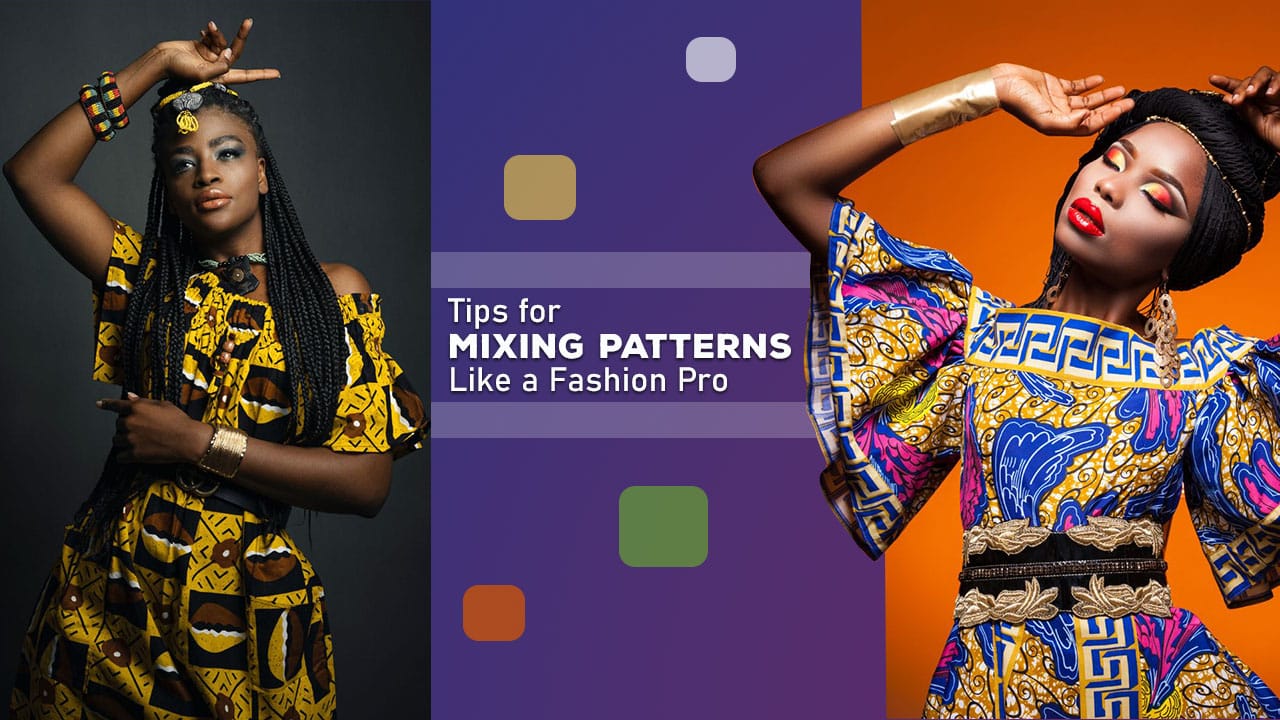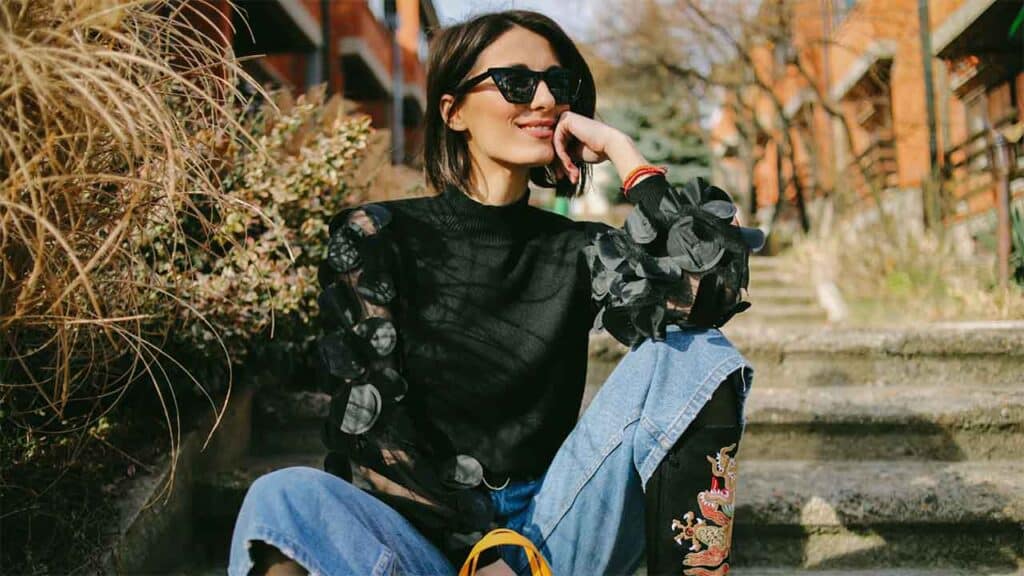Mixing patterns can be tricky, but it’s a skill that can take your fashion game to the next level. Fashion-forward individuals know how to combine different prints and textures to create eye-catching outfits.
Learning to mix patterns like a pro can help you express your unique style and make a bold statement with your clothing choices.
Are you ready to shake up your wardrobe? Mastering pattern mixing will open up a whole new world of outfit possibilities.
Whether you’re pairing florals with stripes or polka dots with plaid, these tips will guide you through combining patterns with confidence and flair.
1. Mix bold prints with neutral ones
Want to mix patterns like a fashion pro? Start by pairing bold prints with neutral ones. This trick creates a balanced look that’s eye-catching but not overwhelming.
Choose a striking print as your main piece. It could be a floral dress or a striped shirt. Then, add a neutral item to tone it down. A solid-colored jacket or pants work well for this.
Neutral colors like black, white, tan, and cream are easy to match. They help the bold print stand out without clashing. This combo lets you show off your style while keeping things classy.
Try a leopard print top with black pants. Or pair a colorful floral skirt with a white blouse. These combos look put-together and stylish without trying too hard.
Remember, the key is balance. Let your bold print be the star, and use neutrals to support it. This way, you’ll create outfits that look effortlessly chic.
2. Balance large patterns with small ones
Mixing patterns can be tricky, but a simple rule can help you nail it every time. When you pair big, bold patterns with smaller, more delicate ones, you create a pleasing visual balance.
Think of a large floral print on a dress. It makes a statement, but it might be too much on its own. That’s where small patterns come in handy. You can add a thin striped belt or a polka dot scarf to break up the big flowers.
The key is to let one pattern take the lead. Your large pattern should be the star of the show. The smaller pattern plays a supporting role, adding interest without stealing the spotlight.
Try this trick with your outfits. Pair a big plaid jacket with a shirt that has tiny checks. Or match wide-striped pants with a top that has small geometric shapes. The contrast in size will make you look more exciting and put-together.
Remember, balance is the goal. Too many big patterns can look messy. Too many small ones might seem boring. But when you mix them just right, you’ll look like a fashion pro.
3. Choose a consistent color palette
Picking a color scheme is key when mixing patterns. Start by selecting patterns that share common colors. This creates a unified look in your outfit.
For example, pair a floral skirt with blue and pink flowers with a striped shirt that has similar shades of blue. The matching colors tie the look together.
Stick to 2-3 main colors in your patterned pieces. This keeps things cohesive without being overwhelming. You can add pops of other colors through accessories later.
Try using different shades of the same color family. A light blue polka dot top can work well with navy striped pants. The varying blue tones create depth while staying coordinated.
Don’t forget about neutrals. Black, white, and beige patterns can mix easily with bolder colored prints. They help balance out louder patterns in your outfit.
4. Use polka dots with stripes
Polka dots and stripes make a great pair. These classic patterns can create eye-catching outfits when combined thoughtfully.
Try a striped top with a polka dot skirt. Keep the colors similar for a cohesive look. A navy striped shirt pairs well with a navy and white polka dot skirt.
You can also mix these patterns in accessories. Wear a striped dress and add a polka dot scarf or handbag for a fun touch.
Pay attention to scale when combining dots and stripes. A small polka dot print works nicely with wider stripes. Or pair tiny stripes with larger dots for contrast.
Don’t be afraid to play with colors. Black and white stripes look striking with colorful polka dots. Or try pastel stripes with bold, bright dots for a playful vibe.
Remember, balance is key. If your top has a busy pattern, choose a simpler bottom. A striped blazer over a polka dot dress creates a stylish, put-together outfit.
5. Combine floral prints with geometric shapes
Mixing floral prints with geometric shapes creates an eye-catching look. This combo adds visual interest to your outfit. You can start small by pairing a floral top with a striped skirt.
Try a floral dress with a geometric print scarf. This adds a pop of contrast. For a bolder look, wear a floral blazer over a dress with geometric patterns.
Balance is key when mixing these prints. Choose pieces where one print is larger and the other is smaller. This helps the patterns complement each other instead of competing.
Colors matter too. Pick geometric shapes in colors that match your floral print. This ties the look together. You can also go for black and white geometric shapes to pair with any floral.
Don’t forget accessories. A geometric-printed bag or pair of shoes can add just the right touch to a floral outfit. This lets you test the waters without going all-in on pattern mixing.
Remember, confidence is your best accessory. When you feel good in your mixed prints, it shows. So have fun and experiment with different floral and geometric combinations.
6. Layer different textures within patterns
Mixing textures adds depth to your outfit. You can do this even when using patterns. Try pairing a smooth silk floral blouse with a rough tweed skirt in a geometric print.
The contrast between the soft and coarse fabrics creates visual interest. It also makes you look more complex and stylish.
Another option is to mix a chunky knit sweater with sleek patterned pants. The difference in textures will catch the eye and elevate your ensemble.
Don’t forget about accessories. A patent leather belt can add shine to a matte patterned dress. Or try a fuzzy scarf with a crisp pinstriped shirt.
When layering textures, keep your color palette cohesive. This helps tie the different elements together. Stick to 2-3 main colors for a polished look.
Remember, texture doesn’t just mean how something feels. It also includes visual texture, like embroidery or beading on a patterned piece.
By playing with different textures, you can make your pattern mixing more exciting. It adds another dimension to your outfit and shows off your style skills.
7. Pair animal prints with solids
Animal prints can be bold and eye-catching. They work well when paired with solid colors. This combo helps balance your look.
Try a leopard print top with solid black pants. Or wear a zebra print skirt with a plain white blouse. The solid color gives your eyes a place to rest.
Neutral solids like black, white, or beige are safe choices. They let the animal print stand out. But don’t be afraid to try bright solids too.
A solid-colored jacket over an animal print dress can tone down the look. This works great for office outfits or more formal events.
Remember, a little animal print goes a long way. Use it as an accent piece if you’re new to this style. A leopard print scarf or snake print shoes can add flair to a simple outfit.
When choosing solids to pair with animal prints, look at the colors in the print itself. Pick out one of those shades for your solid piece. This creates a cohesive look.
8. Break up patterns with belts or accessories
Belts and accessories are your secret weapons for pattern mixing. They can split up busy prints and create a more balanced look.
Try adding a solid-colored belt between two patterned pieces. This breaks up the patterns and gives your eyes a place to rest.
Accessories like scarves, bags, or shoes can also help. Pick one in a solid color or a simple pattern to complement your outfit.
Don’t be afraid to use jewelry. A chunky necklace or bold earrings can draw attention away from clashing patterns.
Remember, less is often more. One or two well-chosen accessories can make a big difference in your pattern-mixed outfit.
9. Start with patterned accessories first
Want to mix patterns but feel nervous? Start small with accessories. A patterned scarf, handbag, or shoes can add flair to your outfit without going overboard.
Try pairing a striped scarf with a solid-colored top. Or wear polka dot shoes with a plain dress. These little touches let you experiment safely.
As you get more comfortable, try mixing patterned accessories together. A floral bag could look great with leopard print shoes. Just keep the rest of your outfit simple.
Accessories are easy to switch out if you don’t like the combination. This makes them perfect for practicing your pattern mixing skills. You can try new ideas without committing to a full outfit.
Remember, confidence is key. Start small, but have fun with it. Soon, you’ll be mixing patterns like a pro in all parts of your wardrobe.
10. Try pattern mixing with tailored pieces
Pattern mixing isn’t just for casual outfits. You can create stylish looks with tailored pieces too. Start with a patterned blazer or suit jacket as your base.
Pair it with a shirt or blouse in a different pattern. For example, try a striped blazer with a polka dot shirt. Keep the patterns different sizes for better balance.
Add a patterned tie or scarf for an extra pop. This works great with solid-colored suits. A floral tie can liven up pinstripes nicely.
Don’t forget about patterned pants or skirts. A plaid skirt looks sharp with a striped top. Just make sure the colors coordinate well.
Accessories are key for tailored pattern mixing. Patterned pocket squares, socks, or shoes can add subtle flair to your outfit.
Remember to keep the fit impeccable. Well-tailored pieces help pull the whole look together, even with bold pattern combos.
11. Use black and white as a common thread
Black and white can be your secret weapon when mixing patterns. These classic colors work with almost anything. They create a link between different prints.
Try pairing a black and white striped top with a colorful floral skirt. The stripes will match the black details in the floral print. This makes the outfit look put-together.
You can also use black and white accessories to tie an outfit together. A black and white polka dot scarf can connect a paisley dress with a plaid jacket. The scarf acts as a bridge between the two patterns.
Don’t be afraid to mix black-and-white patterns with each other. Stripes and checks in these colors can look great side by side. Just make sure to vary the size of the prints for visual interest.
Remember, black and white doesn’t have to be boring. These colors can add sophistication to your pattern mixing. They give your eye a place to rest among busier prints.
12. Focus patterns on one part of your body
Picking one area to show off patterns can make your outfit pop. You might choose your top, bottom, or accessories to be the star.
For example, wear a boldly patterned shirt with plain pants and shoes. This draws eyes to your upper body without being too busy.
Or try patterned pants with a solid color top. This makes your legs the main attraction.
Accessories are another great way to add pattern. A printed scarf or patterned shoes can spice up a simple outfit.
By limiting patterns to one area, you create a balanced look. It’s easier on the eyes and lets the pattern shine without competition.
This trick works well for beginners learning to mix patterns. It’s a safe way to add interest without going overboard.
Remember, the key is to keep the rest of your outfit simple. Solid colors work best to complement your patterned piece.
Understanding Pattern Basics
Patterns are key to creating stylish outfits. Knowing the different types and how colors work together will help you mix patterns like a pro.
Types of Patterns in Fashion
Stripes, polka dots, florals, and plaids are common patterns in fashion. Stripes can be vertical, horizontal, or diagonal. Polka dots come in various sizes. Florals range from small prints to large blooms. Plaids include checks and tartans.
Animal prints like leopard and zebra are popular too. Geometric shapes and abstract designs add modern flair. Paisley swirls and ethnic patterns bring unique cultural touches.
Some patterns are dressy, while others are casual. Tiny prints work well for workwear. Bold patterns make great statement pieces.
Color Theory and Patterns
Colors play a big role in pattern mixing. Complementary colors sit opposite each other on the color wheel. They create high contrast when used together.
Analogous colors are next to each other on the wheel. They blend well for a harmonious look. Monochromatic outfits use different shades of one color.
Neutral colors like black, white, and beige go with almost anything. They can tone down bright patterns. Warm colors like red and orange feel energetic. Cool colors like blue and green are calming.
Pattern scale matters too. Mix large prints with small ones for balance. Stick to a main color scheme to tie different patterns together.
Advanced Techniques for Mixing Patterns
Pattern mixing can be exciting and fun. With a few advanced tricks, you can create eye-catching outfits that show off your style.
Balancing Scale and Proportion
Mix big and small patterns to create visual interest. Pair a large floral print with tiny polka dots. Or try wide stripes with a small geometric design. This contrast helps each pattern stand out.
Keep one pattern as the star. Let it take up more space in your outfit. Then use smaller patterns as accents. This creates a balanced look that’s not too busy.
Try the rule of thirds. Divide your outfit into three parts. Use your main pattern in two-thirds of the look. Fill the last third with a different pattern or solid color.
Using Textures to Enhance Patterns
Add depth to your outfits by mixing textures with patterns. Pair a smooth silk floral blouse with a chunky knit cardigan. The contrast makes both pieces pop.
Play with different fabric weights. A lightweight, patterned scarf can soften a heavy tweed jacket. This mix adds visual interest and keeps your look from feeling flat.
Don’t forget about accessories. A beaded necklace can add texture to a printed dress. Or try pairing patterned shoes with textured tights for a fun twist.
Remember, texture counts as a pattern too. A cable-knit sweater can work like a solid when paired with plaid pants.
Common Mistakes to Avoid
When mixing patterns, it’s easy to make mistakes that can ruin your look. Being aware of these pitfalls will help you create stylish outfits with confidence.
Overloading on Patterns
Too many patterns can overwhelm your outfit. Stick to two or three patterns, max. Pick one main pattern as the star, then add smaller ones as accents. For example, pair a bold floral top with subtle striped pants.
Don’t mix patterns of the same size. Vary the scale to create contrast. Try a large plaid jacket with a small polka-dot shirt.
Keep colors consistent across patterns. Choose patterns with at least one shared color to tie the look together.
Balance busy patterns with solid pieces. Add a plain cardigan or neutral shoes to break up patterned items.
Ignoring Context and Occasion
Some pattern combinations work better in certain settings. Bright, clashing patterns might be fun for a party but not ideal for work.
Consider the dress code. Subtle pattern mixing fits formal events, while bolder mixes suit casual outings.
Think about the season. Floral and pastel patterns work for spring, while plaids and darker hues fit fall.
Match patterns to your body type. Vertical stripes can lengthen, while large prints may overwhelm petite frames.
Pay attention to fabric types. Mixing a silky floral blouse with tweed plaid pants can look odd.
Final Thoughts
Mixing patterns is an art that can elevate your style and set you apart as a fashion-forward individual.
By following these expert tips, you will gain the confidence to create stylish, eye-catching outfits that reflect your unique personality. Remember, the key is to balance boldness with cohesion, allowing your creativity to shine through while maintaining a polished look.
With practice, you’ll soon be mixing patterns like a true fashion pro, turning every outfit into a statement of your personal style.






































